' |
 |
 |
 |
A Decade of Progress After the Fukushima Daiichi NPP Accident: Building on Lessons Learned to Further Strengthen Nuclear Safety
Proceedings Series ¦ STI/PUB/2061 ¦ 111 pages ¦ Date published: 2023
Following the accident at the Fukushima Daiichi nuclear power plant, the lAEA and wider international community, sought to assist the Japanese authorities manage the response. Within the context of continuous improvement and work to ensure the safety of nuclear facilities globally, the nuclear community gathered for this conference to review and assess lessons learned and actions taken, as well as to identify ways to further strengthen nuclear safety.
|
This publication contains the President’s Report and a summary of the technical sessions and policy discussions that took place during the conference. Conclusions of the conference are also summarised.
|
 |
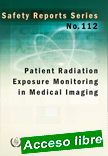 |
Patient Radiation Exposure Monitoring in Medical Imaging
Safety Reports Series No. 112 ¦ English ¦ STI/PUB/1976 ¦ 117 pages ¦ Date published: 2023
Written to assist the implementation in medical imaging practice of the requirements of the IAEA Safety Standards Series No. GSR Part 3, Radiation Protection and Safety of Radiation Sources: International Basic Safety Standards, this publication provides consolidated information and detailed advice for setting and implementing patient radiation exposure monitoring programmes at the local or national level.
|
In medical imaging using ionizing radiation, including X ray diagnostic radiology, diagnostic nuclear medicine and image guided interventional procedures, radiation protection of patients is achieved by selecting the most appropriate imaging procedure for the individual needs of the patient and by keeping exposure to the minimum necessary to achieve the diagnostic and interventional objective. Monitoring of radiation exposure of patients provides critical information for health care professionals and authorities who are responsible for ensuring justified and optimized use of radiation in medicine. This Safety Report provides guidance on recording, collecting and analysing relevant patient exposure data by using manual or automatic means. An aim of the publication is to encourage the future use and development of automatic digital systems to improve access to information about patient radiation exposure and thus contribute to improved implementation of the requirements for radiation protection of patients throughout the world.
|
 |
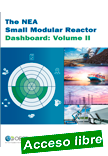 |
The NEA Small Modular Reactor Dashboard: Volume II
English ¦ Nuclear Energy Agency, OECD ¦ NEA No. 7657 ¦ 68 pages ¦ Date published: 2023
All low-carbon solutions will be required to achieve the world's net zero targets. Nuclear energy has a role to play in meeting this need. A wave of innovation in small modular reactors (SMRs) is advancing quickly with the potential to help decarbonise hard-to-abate sectors. Progress is real and is positioned to accelerate pathways to net zero. SMRs could replace coal on-grid, fossil fuel cogeneration of heat and power for heavy industry, diesel at off-grid mines, as well as producing hydrogen and synthetic fuels.
|
Looking beyond technical feasibility, The NEA Small Modular Reactor Dashboard defines new criteria for assessing real progress in six additional dimensions of readiness: licensing, siting, financing, supply chain, engagement, and fuel. The first volume of The NEA Small Modular Reactor Dashboard assessed the progress of 21 SMRs. This second volume tracks the progress of an additional 21 SMRs around the world.
|
 |
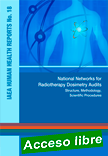 |
National Networks for Radiotherapy Dosimetry Audits: Structure, Methodology, Scientific Procedures
IAEA Human Health Reports No. 18 ¦ STI/PUB/1964 ¦ 126 pages ¦ Date published: 2023
The IAEA has a long-standing history of providing radiotherapy dosimetry audits in its Member States. This publication summarizes the methodologies resulting from the work of four coordinated research projects (CRPs) and offers information on experiences collected during the development of dosimetry audit programmes and their implementation at national levels.
|
It also sets the framework and provides advice on the structure of dosimetry audit centres and discusses the general approach for audit development and the necessary background to conduct dosimetry audits in radiotherapy by national organizations. It provides technical and scientific details, as well as practical experiences of the audit steps developed under these CRPs. Any organization developing national audit programmes for radiotherapy can use this publication as a reference and to learn from the experiences of other national audit networks.
|
 |
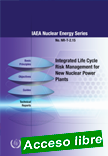 |
Integrated Life Cycle Risk Management for New Nuclear Power Plants
IAEA Nuclear Energy Series No. NR-T-2.15 ¦ English ¦ STI/PUB/2047 ¦ 153 pages ¦ Date published: 2023
Integrated risk management (IRM) is particularly important during the preparation and construction phases of a nuclear power plant (NPP) and anticipates the risks that could arise during the operation and decommissioning phases. This publication is designed to enhance stakeholders' understanding of the fundamental processes, procedures, and methods for IRM.
|
Practical guidelines are provided and best practices shared. The importance of having appropriate risk management policies, especially when considering the various contractual and organizational arrangements in different construction entities, operating organizations and Member States is emphasized. Tables are provided throughout the publication to indicate the causes of risks and their impacts on the applicable NPP or project. Economic evaluation techniques are also introduced. Member States contemplating expanding their existing nuclear power plant fleets can be expected to benefit from this publication, but it will likely be most valuable for Member States newly embarking upon a nuclear power programme.
|
 |
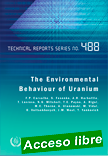 |
The Environmental Behaviour of Uranium
Technical Reports Series No. 488 ¦ STI/DOC/010/488 ¦ 361 pages ¦ Date published: 2023
This publication is one of the series of IAEA publications on the environmental behaviour of naturally occurring radionuclides. It outlines uranium behaviour in different environments, as well as its transfer to, and metabolism in, humans. The publication also provides concepts, models and data required for the assessment of the impacts of uranium on non-human biota. Assessing the environmental and health effects of uranium poses specific challenges because of the combination of different types of hazard and potential exposures.
|
Therefore, both the radiotoxicity and chemical toxicity of uranium are considered in this publication.
|
 |
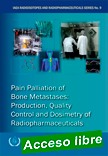 |
Pain Palliation of Bone Metastases : Production, Quality Control and Dosimetry of Radiopharmaceuticals
IAEA Radioisotopes and Radiopharmaceuticals Series No. 9 ¦ STI/PUB/2042 ¦
141 pages ¦ Date published: 2023
Radionuclide therapy using bone targeting radiopharmaceuticals is an effective palliative care option to reduce pain associated with advanced disease with bone metastases. Over the last 20 years, suitable therapeutic radionuclides are more widely available, meaning that the benefits of pain palliation therapy could reach more patients.
|
This publication provides a broad overview on the current status of radiopharmaceuticals for bone pain palliation. It covers production of radionuclides, identification of bone seeking carrier molecules, preparation of stable complexes, in vitro and in vivo evaluations and dosimetry studies which are part of the development of these radiopharmaceuticals for clinical use. Details on production and quality control of the currently available products, provided here will be of use to scientists involved in the development of these radiopharmaceuticals.
|
 |
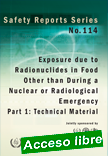 |
Exposure due to Radionuclides in Food Other than During a Nuclear or Radiological Emergency. Part 1: Technical Material
Safety Reports Series No. 114 ¦ STI/PUB/1986 ¦ 182 pages ¦ 22 figures ¦ Date published: 2023
Radionuclides of both natural and human made origin exist throughout the environment. These radionuclides can be transferred to plants and animals that are consumed by humans, thereby resulting in exposure to ionizing radiation and an internal radiation dose. This Safety Report provides information on the observed distributions of concentrations of natural radionuclides in various food products, on the use of ‘total diet’ and other studies to assess ingestion doses, and on radionuclide concentrations in natural mineral waters.
|
Different dose assessment methodologies are presented and the advantages and disadvantages of each is discussed, along with approaches used for managing non-radioactive contaminants in food. This publication is jointly sponsored by the IAEA, the Food and Agriculture Organization of the United Nations and the World Health Organization. It is intended to support Member States in the assessment and management of radionuclides in food, and the alignment of national policies with Requirement 51 of IAEA Safety Standards Series No. GSR Part 3, related to radionuclides in food and drinking water.
|
 |
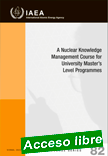 |
A Nuclear Knowledge Management Course for University Master’s Level Programmes
Training Course Series No. 82 ¦ 31 pages ¦ Date published: 2023
Knowledge management has established itself as a key strategic approach for the management of intellectual assets in many successful organizations. Nuclear knowledge, nuclear facilities and the nuclear industry can be complex and multifaceted with a need for firm and sizable commitments over long timeframes. For organizations dealing with nuclear science and technology, knowledge management throughout these long timeframes can improve safety and efficiency, increase innovation and help preserve and enhance current knowledge.
|
The objective of the publication is to support Member States, particularly universities, to establish a master’s level course in nuclear knowledge management. The learning objective of the course is to understand how to establish a knowledge management culture and practice as a part of national capacity building policies and strategies, as well as an integral part of nuclear and radiological organizations’ infrastructure.
|
 |
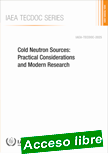 |
Cold Neutron Sources: Practical Considerations and Modern Research
IAEA-TECDOC-2025 ¦ 168 pages ¦ 67 figures ¦ Date published: 2023
Analysis of materials using neutron scattering usually requires thermal and cold neutrons rather than those at the higher energies typically liberated by nuclear reactions. Cold neutrons are particularly useful for studying materials characterised by large dimensions, such as polymers, biological materials, and magnetic materials with complex structures.
|
This publication provides a practical overview of considerations when building a cold neutron source, including neutronics and heat removal, design considerations, materials choices and fabrication methods, safety, and licensing. It also describes some typical project management aspects and a path through the steps from installation, commissioning, benchmarking, into operation and eventual decommissioning. In addition, a section describing recent research and development themes including modern moderator materials, catalysts for para hydrogen production, geometrical optimization, scattering kernels, and recent developments in Monte Carlo codes for modelling and optimization is included. The publication has been written for use by all those involved in a project to build a cold neutron source. The publication also includes five annex articles describing experiences with cold sources at reactor- and accelerator-based neutron sources.
|
 |
| |
|
|

|
|
|
| |
|
|
| |
| |
|
|
| |
| |
|
|
| |
| |
|
|
|
| |
| |
